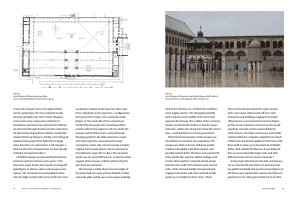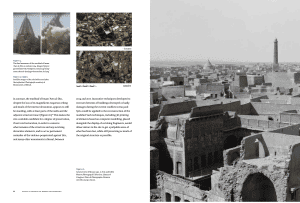Working to improve mutual understanding between the Middle East and the West
Working to improve mutual understanding between the Middle East and the West
No products in the basket.
An impressive collection of essays by distinguished scholarly authors to celebrate the career of Robert Hillenbrand.
Carole and Robert Hillenbrand are acclaimed academics who have made immense contributions to the fields of Islamic history and art history. The respect and affection of the academic community towards them is legendary. For these two volumes, editors Ali Ansari and Melanie Gibson have gathered a wide-ranging selection of scholarly essays by some of their longstanding colleagues as well as by recent students who now occupy academic positions across the world. The volume dedicated to Robert Hillenbrand includes thirteen articles on subjects which include studies on a rare 8th-century metal dish with Nilotic scenes, Chinese Qur’ans, the process of image making in both theory and practice, and a shrine in Mosul destroyed by ISIS.
Robert Hillenbrand is a Fellow of of the British Academy, Emeritus Professor in Islamic Art History at the University of Edinburgh and an Honorary Professorial Fellow at the University of St Andrews.
Melanie Gibson is Senior Editor of the Gingko Library Arts Series. Her publications focus on sculpture, ceramics and glass produced around the Islamic world.
| Theme | Art |
|---|
Foreword 6
Melanie Gibson and Ali Ansari
Robert Hillenbrand: An Appreciation 8
Melanie Gibson
Robert Hillenbrand: Publications 10
A Builder of Mosques: The Projects of al-Walid I, from Sanaa to Homs 16
Alain George
Back to Tulul al-Ukhaydir 50
Barbara Finster
Twin Minarets in the Architecture of Iran 64
Lorenz Korn
Memorial for a Memorial: The Mashhad of Imam ʿAwn al-Din and the Destruction of Medieval Monuments in Mosul by ISIS 78
Richard P. McClary
David Talbot Rice and Persian Art History 92
Yuka Kadoi
Beyond the Beholder’s Share: Painting as Process 100
Marga ret S. Graves
Blurred Boundaries: Interactions Between Royal Ateliers and Commercial Workshops in the Persianate World 132
Udayan Da niel Ghose
Some New Uses of the Geniza: Mercantile Letter—On the Materiality of Writing in the Indian Ocean World 158
Elizabeth La mbourn
Beyond the Taklamakan: The Origins and Stylistic Development of Qurʾan Manuscripts in China 180
Marcus Fraser
Syrian Nilotics and the History of Silver Inlay in the Near East 200
James Allan
An Ayyubid-era Figural Ivory: A Sculptural Miniature 222
Julian Raby
‘Healing for what is in the Breasts’: Ceramic Breastfeeding Figures from the Medieval Islamic World 240
Melanie Gibson
Chinese Porcelains from the Ardabil Shrine: Collecting and Display in Iran 268
Linda Komaroff
Author Biographies 286
Alain George
A Builder of Mosques: The Projects of al-Walid I, from Sanaa to Homs
The Umayyad Caliph al-Walid I (r. 86–96/705–15) is mostly remembered today as the founder of the Great Mosque of Damascus.1 But during the short decade of his reign, he also built a string of other mosques, from Homs in the north to Sanaa in the south, as well as palaces, granaries, and other structures.2 By the ninth century, his image as a builder had become something
of a topos in Arabic literature, with some of the embellishments that this often entails.3 His patronage of mosques, however, was on a truly extraordinary scale and it broke with patterns inherited from the first decades of Islam. The present study aims
to map and contextualise this phenomenon.4 It is
a small tribute to Robert Hillenbrand, whose own scholarship on the history of Umayyad art and architecture needs no introduction.5
Eight mosques that can be securely ascribed to al-Walid will be considered in sequence: the Great Mosque of Damascus; the Prophet’s Mosque in Medina; the Qubaʾ Mosque near Medina; the Masjid al-Haram in Mecca; the great mosques of Sanaa, Fustat and Homs; and the Aqsa in Jerusalem [Figure 1].6 I will assemble the available evidence on their size, form, ornament and inscriptions, as well as their dates of construction, the way caliphal orders were conveyed, and the names of the supervisors in charge. Despite the existence of seminal studies on some of the buildings—Jean Sauvaget’s work on Medina immediately springs to mind—this data is not as easy to gather as one might expect. Each modern author wrote with a different focus and in the architecture itself, only the mosques of Damascus, Jerusalem and Sanaa have any physical remains left from the Umayyad period. Much of the evidence still lies in primary sources that pose interpretive issues of their own.7 The present studyis thus primarily devoted to establishing the facts, which are inevitably more or less clear-cut, and more abundant for some mosques than for others. Having thus set the basic parameters, I will turn to broader chronological, geographical and political trends in al-Walid’s programme.
Before proceeding, the issue of measurement units ought to be mentioned as it has a bearing on building sizes. The main unit used for architecture in Arabic sources, the cubit could be measured with rope and other tools but also as the length between the elbow and tip of the stretched index, which is obviously both more practical and less precise.8 The conversion of Islamic units into modern ones is just as problematic. Two cubits are known from the early Islamic period: the first (54–56 cm) occurs at several major Umayyad and Abbasid monuments; the second (44.75 cm) was measured on the Umayyad water gauge at al-Muwaqqar, and it nearly tallies with the Byzantine foot of 30.89 cm attested at an aqueduct near Bethlehem, which suggests it may have been used in parts of Greater Syria.9 The difference between these two sets of values is significant—about twenty percent—so it might give an unwarranted impression of accuracy to arbitrarily opt for either of them or an average.
I will therefore give metrical conversions as a range corresponding to 44–56 cm to the cubit.10 Although this is less satisfactory than a precise figure, it is also more faithful to the data.
1.I thank Harry Munt and Andrew Marsham for sharing useful references and ideas as we discussed this topic. Luke Treadwell and an anonymous reviewer also provided helpful comments on the essay. Any shortcomings naturally remain my own. I am also grateful to James Allan for scouring his personal archive in search of relevant photographs of the Yemen and to Susannah Cogan for her help with document scanning.
2. For building work by al-Walid attested in contemporary administrative papyri, see Federico Morelli, ‘Legname, palazzi e moschee: P. Vindob. G31 e il contributo dell’Egitto alla prima architettura islamica’, Tyche: Beitrage zur Alten Geschichte Papyrologie und Epigraphik 18, 1998, 165–90.
3. Lawrence Conrad, ‘Did Al-Walid Found the First Islamic Hospital?’ Aram 6, 1994, 225–44.
4. The most complete overviews so far are Barbara Finster, ‘Die Mosaiken der Umayyadenmoschee von Damaskus’, Kunst des Orients 7, 1970–71, 127–39; Finbarr Barry Flood, The Great Mosque of Damascus: Studies in the Makings of an Umayyad Visual Culture, Leiden 2000, 186–213. The mosques of Medina, Fustat and Damascus are discussed individually in K.A.C. Creswell, Early Muslim Architecture, Volume I: Umayyads, A.D. 622–750, Part I, second edition, Oxford 1969, chapters 7–8.
5. See for instance, in the list of his publications in this volume, ‘La Dolce Vita’, 1982; ‘Islamic Art at the Crossroads’, 1981; ‘Umayyad Woodwork’, 1999; ‘Anjar and Early Islamic Urbanism’, 1999; ‘Reflections on the Mosaics’, 2012; ‘Hishām’s Balancing Act’, 2018.
6. Work on the Umayyad Mosque of Aleppo may have begun under either al-Walid or his brother and successor Sulayman; Thallein Antun, The Architectural Form of the Mosque in the Central Arab Lands, from the Hijra to the End of the Umayyad Period, 1/622-133/750, Oxford 2016, 99. The mosque excavated at Iskaf Bani Junayd in Iraq could arguably have been built in the early eighth century, but this remains uncertain; Antun, The Architectural Form of the Mosque, 14–15. Many smaller mosques in Medina are said to have been founded by al-Walid and ʿUmar ibn ʿAbd al-ʿAziz by later sources, but these seem like historiographical constructs meant to increase their sacred aura; Harry Munt, The Holy City of Medina: Sacred Space in Early Islamic Arabia, New York 2014, 111–14.
7. For a brief discussion with further references, see Alain George, The Umayyad Mosque of Damascus: Art, Faith and Empire in Early Islam, London 2021, 16, 22–24.
8. For an example of this variability at the Prophet’s Mosque in Medina, see Jean Sauvaget, La mosquée omeyyade de Médine: Etude sur les origines architecturales de la mosquée et la basilique, Paris 1947, 70, n. 6.
9. K.A.C. Creswell and J.W. Allan, A Short Account of Early Muslim Architecture, Revised Edition by J.W. Allan, Aldershot 1989, 121, 180, 186; R. Grafman and M. Rosen-Ayalon, ‘The Two Great Syrian Umayyad Mosques: Jerusalem and Damascus’, Muqarnas 16, 1999, 13, n. 19; R. W. Hamilton, ‘An Eighth-Century Water Gauge at al-Muwaqqar’, Quarterly of the Department of Antiquities in Palestine XII, 1946, 70–72; F.-M. Abel, ‘Inscription grecque de l’Aqueduc de Jérusalem avec la figure du pied byzantin’, Revue Biblique 35, 1926, 284–88. The cubit is equal to 1.5 foot, so the Bethlehem aqueduct cubit was about 46.33 cm. Frédéric Morin has argued that different cubits were used in the same Umayyad buildings and that they were linked by trigonometric relationships, but this hypothesis has not been fully substantiated; P. Carlier and F. Morin, ‘Recherches archéologiques au château de Qastal (Jordanie)’, Annual of the Department of Antiquities of Jordan 28, 1984, 347–49.
10. Values within this range are also attested in later Islamic contexts; see Walter Hinz, Islamische Masse und Gewichte umgerechnet ins metrische System, Leiden 1955, 55–56, 60–61. Larger cubits also existed in some periods and regions, but they are not attested in early Islam.



‘Fruit of Knowledge, Wheel of Learning contains a series of essays as engaging and diverse in their interests and subject matters as the man they celebrate. As many of the contributors are Robert Hillenbrand’s former students, they also testify to his abilities as a learned and inspiring teacher.’
–Scott Redford, Nasser D Khalili Professor of Islamic Art and Archaeology, SOAS, University of London
‘In its thematic breadth, intellectual depth, and innovative thinking Fruit of Knowledge, Wheel of Learning is indeed a befitting academic tribute to honour one of the giants in the field of Islamic art today. At the same time, it speaks of Robert’s outstanding calibre as a teacher and mentor, fostering the next generation of scholarly thought leaders at the top of their game.’
–Ulrike Al-Khamis, Director and Chief Executive Officer, Aga Khan Museum, Toronto
‘This beautifully produced volume ranges in time from early Islam to early modernity, in geography from Anatolia to China, and in medium from architecture to the portable arts, painting and paper. The extraordinary range of the contributors’ essays offers a fitting tribute to the inspiring and pioneering scholarship of a towering figure in the history of Islamic art and architecture.’
–Finbarr Barry Flood, William R. Kenan Jr. Professor of the Humanities, New York University
Our work relies on the generous support of our donors. Any contribution, no matter how small, helps us achieve our aims.